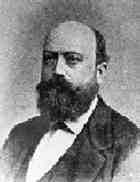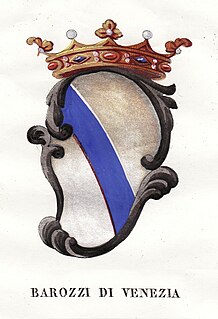
Giuseppe Peano was an Italian mathematician and glottologist. The author of over 200 books and papers, he was a founder of mathematical logic and set theory, to which he contributed much notation. The standard axiomatization of the natural numbers is named the Peano axioms in his honor. As part of this effort, he made key contributions to the modern rigorous and systematic treatment of the method of mathematical induction. He spent most of his career teaching mathematics at the University of Turin. He also wrote an international auxiliary language, Latino sine flexione, which is a simplified version of Classical Latin. Most of his books and papers are in Latino sine flexione, others are in Italian.

Count Angelo De Gubernatis, Italian man of letters, was born in Turin and educated there and at Berlin, where he studied philology. He was nominated for the Nobel Prize in Literature fourteen times.

Corrado Segre was an Italian mathematician who is remembered today as a major contributor to the early development of algebraic geometry.

Mario Pieri was an Italian mathematician who is known for his work on foundations of geometry.

Francesco Maurolico was a mathematician and astronomer from Sicily. He made contributions to the fields of geometry, optics, conics, mechanics, music, and astronomy. He edited the works of classical authors including Archimedes, Apollonius, Autolycus, Theodosius and Serenus. He also composed his own unique treatises on mathematics and mathematical science.

Anne Marie d'Orléans was the first queen of Sardinia by marriage to Victor Amadeus II of Savoy. She served as regent of Savoy during the absence of her spouse in 1686 and during the War of the Spanish Succession. She is also an important figure in British history.

Eugenio Elia Levi was an Italian mathematician, known for his fundamental contributions in group theory, in the theory of partial differential operators and in the theory of functions of several complex variables: he was a younger brother of Beppo Levi and was killed in action during First World War.

Francesco Gerbaldi was an Italian geometer, who proved Gerbaldi's theorem.

Gustavo Sannia was an Italian mathematician working in differential geometry, projective geometry, and summation of series. He was the son of Achille Sannia, mathematician and senator of the Kingdom of Italy.

Isabella Fabbrica was an Italian operatic contralto.

Enrico Bompiani was an Italian mathematician, specializing in differential geometry.

Pietro De Martino or Di Martino was an Italian mathematician and astronomer.

Ovidio Montalbani was an Italian mathematician.

Giuseppe Basso (1842–1895) was an Italian mathematician.

Pietro Paleòcapa was an Italian scientist, politician and engineer.

The Barozzi were an aristocratic Venetian family. Members of the family became sailors, clerics and men of learning. They were lords of Santorini and Thirassia, and held military fiefs on the island of Crete. Members of the family were involved in the conspiracy of Bajamonte Tiepolo against the Doge of Venice in 1310.

Achille Sannia was an Italian mathematician and politician.

Cristoforo Alasia de Quesada (1864–1918) was an Italian mathematician.

Antonino D’Antona was born in Riesi (Caltanisetta) on December 18th 1842 by Antonino and Concetta Debilio. After completing his classical studies in Sicily and after enrolling at the University of Palermo, where he attended the first four years of the medical course, he moved to Naples. He was guided since childhood by the care of a paternal uncle, the archpriest Gaetano D'Antona, who also followed him in the years of his university education. Antonino only had one child: Carlo D’Antona.



















